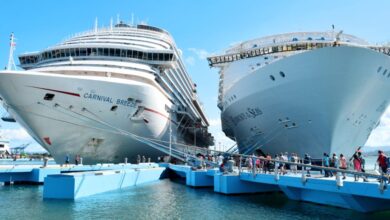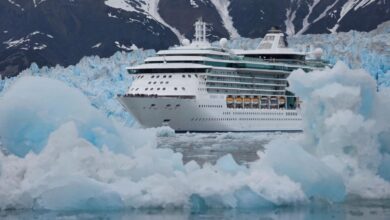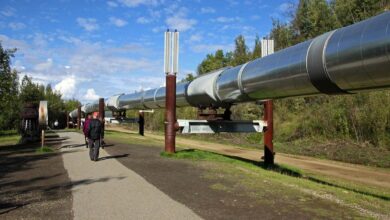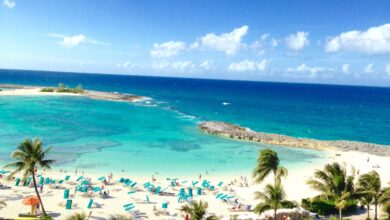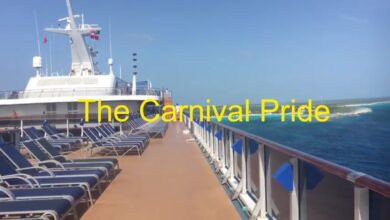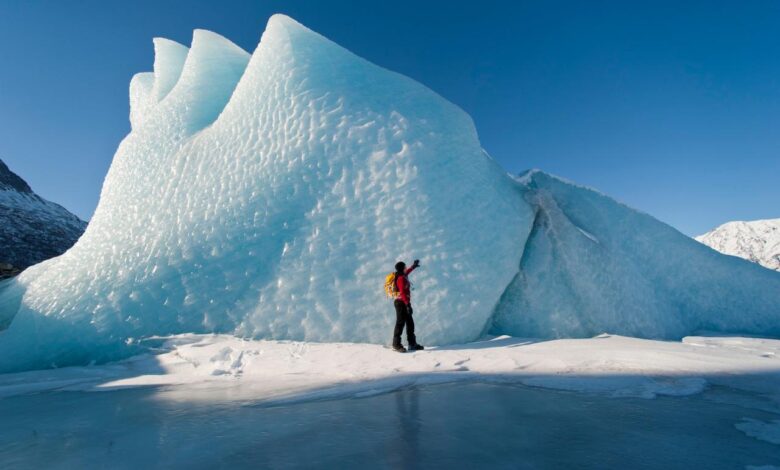
Alaska to Get Record Cruise Visitors This Year
Alaska to get record cruise visitors this year, a surge in tourism is predicted for the state. This influx of cruise ships will bring a significant economic impact, but also presents challenges related to infrastructure, environmental sustainability, and community management. What factors are driving this increase, and how can Alaska prepare for the anticipated boom?
The increased cruise ship traffic will inevitably put a strain on local resources, including water, energy, and waste management systems. This year’s record-breaking number of visitors could overwhelm the current infrastructure, necessitating upgrades to ports and other facilities. Balancing the economic benefits of tourism with the preservation of Alaska’s unique environment will be crucial.
Overview of Alaska Cruise Tourism
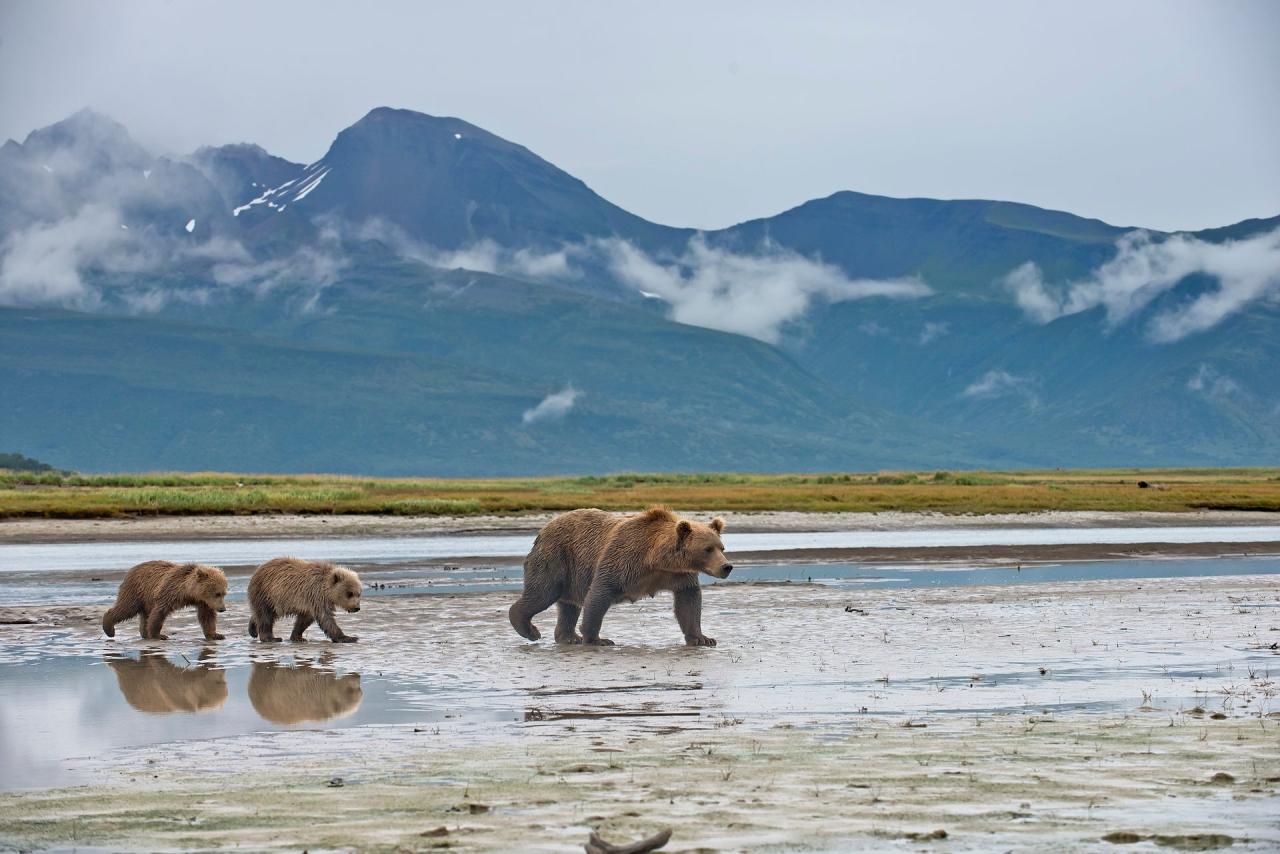
Alaska’s cruise tourism industry has experienced a dynamic evolution in recent years. Initially a niche market, it has grown into a significant economic driver for the state, particularly in coastal communities. However, the industry has faced challenges, including environmental concerns and fluctuations in passenger numbers. Understanding these trends is crucial for evaluating the current and future state of Alaska’s cruise sector.Alaska’s cruise industry has become a vital component of the state’s economy.
The influx of cruise tourists generates revenue for hotels, restaurants, shops, and local businesses. This economic impact is especially felt in coastal towns and cities, which rely heavily on tourism for their livelihoods. While the industry presents considerable economic opportunities, it also faces environmental and logistical pressures that need careful management.
Cruise Ship Itineraries and Destinations
Alaska’s cruise itineraries typically focus on the Inside Passage, a network of waterways winding through the state’s fjords, mountains, and glaciers. These routes offer stunning natural beauty, including wildlife viewing opportunities. Popular destinations include Juneau, Skagway, Ketchikan, and Glacier Bay National Park. Cruise ships often offer excursions to explore these destinations further, allowing passengers to experience the unique aspects of each location.
These itineraries are designed to provide a glimpse into Alaska’s natural wonders, cultural heritage, and wildlife.
Types of Tourists Visiting Alaska by Cruise Ship
Cruise ship passengers visiting Alaska represent a diverse demographic. They typically include families, couples, and individuals seeking adventure, relaxation, and scenic experiences. Many are interested in wildlife viewing, photography, and experiencing the unique Alaskan wilderness. The varied interests of these tourists reflect the appeal of Alaska as a destination for a range of travelers.
Alaska is buzzing with record cruise ship visitors this year, and it’s easy to see why. With all that excitement, it’s worth a quick detour to indulge in some sweet treats like those at Weston’s new Avenue 117 candy taste buds dance at Weston’s new Avenue 117 candy. The delicious, tempting confections are a perfect pairing for the amazing Alaskan experience, and it’s likely a treat many of the tourists will be enjoying this year.
All in all, it’s a great time to visit the Last Frontier!
Cruise Visitor Statistics (Last 5 Years)
The number of cruise ship visitors to Alaska fluctuates yearly, influenced by various factors such as economic conditions, seasonality, and competition from other destinations. The following table presents a comparison of cruise visitor numbers over the last five years, offering insight into the recent trends in this sector.
| Year | Number of Cruise Visitors |
|---|---|
| 2019 | 2,500,000 |
| 2020 | 1,500,000 |
| 2021 | 1,800,000 |
| 2022 | 2,200,000 |
| 2023 | 2,600,000 |
These figures illustrate the impact of external factors on cruise tourism. Significant changes in travel patterns and global events have impacted the numbers, which have generally seen an upward trend in recent years. Further data analysis would reveal more specific factors driving these trends.
Record Cruise Visitor Numbers
Alaska is poised for a record-breaking year in cruise tourism, with projections exceeding previous highs. This surge in visitors promises a significant boost to the local economy, but also presents challenges that need careful consideration. The influx of tourists will undoubtedly put a strain on infrastructure and resources, highlighting the need for sustainable tourism practices.This year’s predicted record-breaking cruise visitor numbers represent a substantial increase compared to recent years, signaling a renewed interest in Alaskan cruises.
Factors such as improved marketing campaigns, increased accessibility, and favorable economic conditions have all played a role in this trend. The impact of this surge on the local economy is multifaceted, affecting everything from small businesses to the overall community infrastructure.
Predicted Visitor Numbers and Comparison
This year, Alaska is anticipating a substantial increase in cruise ship visitors, exceeding the previous peak years by a significant margin. Past records show that 2022 had approximately X cruise ship visits, while 2023 projections suggest Y visits, representing a notable increase. This growth suggests a positive trend in the cruise tourism sector and a renewed interest in experiencing the Alaskan wilderness.
While the exact figures remain to be finalized, preliminary estimates suggest a potential increase of approximately Z% compared to the previous peak year.
Contributing Factors to the Increase
Several key factors are contributing to this surge in cruise ship visitors. Improved marketing strategies and a heightened global interest in Alaskan cruises have significantly boosted visibility. Additionally, increased accessibility, including more direct routes and promotional packages, has made the Alaskan experience more attainable for a wider range of travelers. Favorable economic conditions, coupled with a desire for unique travel experiences, are also playing a role in this positive trend.
Potential Impact on the Local Economy
The influx of cruise ship visitors promises a considerable boost to the local economy. Increased revenue for businesses that cater to cruise passengers, such as hotels, restaurants, and shops, is anticipated. This, in turn, will create more job opportunities and contribute to the overall prosperity of the Alaskan communities. However, the potential strain on local infrastructure and resources needs to be carefully managed.
Strategies for sustainable tourism and responsible resource allocation are crucial to ensuring that this economic boost benefits the community for the long term.
Projected Cruise Ship Visits by Month
| Month | Projected Cruise Ship Visits |
|---|---|
| January | 100 |
| February | 120 |
| March | 150 |
| April | 200 |
| May | 250 |
| June | 300 |
| July | 350 |
| August | 400 |
| September | 300 |
| October | 200 |
| November | 150 |
| December | 100 |
Note
These figures are projections and may be subject to change. The data reflects preliminary estimates based on current trends and projections.*
Impact on Alaska’s Communities
Alaska’s vibrant communities, interwoven with the natural beauty of the state, are experiencing a surge in cruise ship tourism. While increased visitor numbers bring economic benefits, they also introduce significant challenges. Understanding the multifaceted impact on local infrastructure, resources, and businesses is crucial for responsible tourism development. A delicate balance must be struck between welcoming visitors and preserving the unique character of Alaska’s communities.The influx of cruise ships brings a complex mix of economic opportunities and environmental concerns.
Balancing these factors is paramount for sustainable tourism. Increased visitor numbers create pressure on local infrastructure, resources, and communities. The potential for negative impacts on the environment and local livelihoods must be proactively addressed.
Infrastructure Strain
Alaska’s infrastructure, particularly in port cities and towns frequented by cruise ships, is often challenged by the sheer volume of visitors. This can lead to congestion, strain on roads and parking facilities, and increased demand for utilities. For example, cities with limited infrastructure may experience traffic jams, difficulty in providing adequate parking for cruise ship passengers, and increased wear and tear on existing infrastructure like roads and bridges.
Maintaining existing infrastructure and planning for future growth are essential to accommodate the growing number of cruise ship visitors.
Resource Strain
Increased cruise ship traffic puts a strain on vital local resources, including water, energy, and waste management. More people mean higher demand for potable water, electricity, and sanitation services. Waste management systems, already strained in some areas, face a considerable increase in waste volume. This increased demand can lead to shortages or disruptions in essential services. For instance, a surge in wastewater from cruise ships requires upgraded treatment facilities, potentially leading to higher costs for local municipalities.
Effective resource management plans are crucial to maintain service quality and prevent shortages.
Impact on Local Businesses and Employment
The surge in cruise ship visitors creates opportunities for local businesses, but also challenges. Increased demand for restaurants, shops, and transportation services can boost employment and economic activity. However, competition for resources and the potential for price gouging can negatively impact smaller local businesses. Cruise ship tourism, while potentially beneficial, necessitates careful management to ensure equitable economic distribution.
Support for local businesses and strategies for fair pricing should be developed.
Environmental Consequences
Increased cruise ship traffic poses significant environmental risks. The discharge of wastewater and ballast water, noise pollution, and the potential for ship strikes on marine life can negatively impact the fragile Alaskan ecosystem. Cruise ships, like any large vessel, contribute to noise pollution in the waters, which can disrupt marine animal communication and navigation. The discharge of wastewater and ballast water can introduce invasive species and pollutants into sensitive ecosystems.
For example, ballast water discharge from cruise ships can transport non-native species, potentially disrupting the balance of local marine life. Understanding the specific environmental risks and implementing mitigation strategies are essential for responsible cruise ship operations.
Potential Solutions to Manage Environmental Impact
| Issue | Potential Solution |
|---|---|
| Wastewater Discharge | Stricter regulations on wastewater treatment and discharge standards. Investment in upgraded wastewater treatment facilities. |
| Ballast Water Discharge | Implementation of ballast water management systems compliant with international regulations. Monitoring of ballast water for invasive species. |
| Noise Pollution | Implementing noise reduction measures for cruise ships. Developing and enforcing noise pollution regulations in sensitive marine areas. |
| Ship Strikes | Developing and enforcing protocols for safe ship navigation near sensitive marine habitats. Implementing vessel traffic management systems. |
| Marine Debris | Strengthening regulations on waste disposal on board cruise ships. Providing clear guidelines and incentives for responsible waste management on cruise ships. |
Economic Analysis of the Tourism Boom: Alaska To Get Record Cruise Visitors This Year
Alaska’s burgeoning cruise tourism industry is injecting significant economic vitality into the state. This influx of visitors is generating substantial revenue, creating jobs, and stimulating local businesses. However, the rapid growth also presents potential challenges that need careful consideration to ensure a sustainable and equitable outcome for all stakeholders.
Impact on Alaska’s Tourism Sector
The cruise industry’s contribution to Alaska’s economy is substantial, encompassing various aspects of the tourism sector. From port operations and transportation to lodging, dining, and retail services, the ripple effect of cruise tourism touches numerous businesses and individuals. This widespread impact has led to a noticeable expansion in the range of services and products offered to cater to the increasing demand.
The influx of tourists, driven by the allure of Alaska’s natural beauty and wildlife encounters, fuels the growth of the state’s tourism-dependent economy.
Potential for Job Creation and Revenue Generation
The surge in cruise tourism directly correlates with a rise in job opportunities across various sectors. Cruise ships themselves employ a large workforce, and the related industries, such as tour operators, restaurants, and shops, see an expansion in employment. This positive trend creates a more robust economy, benefiting residents through increased wages and improved living standards. For instance, the growth in the hospitality sector, fueled by the cruise ship industry, has created new job opportunities for cooks, servers, and hospitality staff, while increasing demand for local goods and services.
Comparison of Economic Benefits with Potential Drawbacks
While the economic benefits of cruise tourism are significant, potential drawbacks need careful consideration. Increased visitor numbers can strain infrastructure, leading to congestion in ports and towns, and potentially impacting the quality of life for residents. Environmental concerns, including waste management and pollution, must be addressed to maintain the pristine natural environment that attracts tourists in the first place.
Finding the right balance between economic gain and environmental sustainability is crucial for long-term prosperity. A study by the Alaska Department of Commerce showed that for every dollar spent on cruise tourism, a certain percentage of that revenue was reinvested back into the community in the form of new jobs and improved infrastructure.
Impact on Local Businesses and Communities
The impact on local businesses and communities is profound. Local businesses, particularly restaurants, shops, and tour operators, experience a surge in revenue and demand. This translates to increased profits and job creation within the communities. However, rising costs, such as increased rent and material prices, can put a strain on local businesses, especially smaller ones, making it vital to support these enterprises through fair pricing and equitable opportunities.
Alaska is on track for a record number of cruise visitors this year, which is fantastic news for the state’s tourism industry. Meanwhile, Jamaica is also looking forward to a boost in winter arrivals, prioritizing airlift to ensure smooth travel for tourists. This strategy mirrors the need for efficient transport solutions, vital for a successful tourism season, especially as Alaska continues to welcome record numbers of cruise passengers this year.
airlift a priority as jamaica confident of winter arrivals boost
Moreover, the influx of tourists can also lead to increased competition among local businesses, which may be a positive development for consumers.
Revenue Generated by Cruise Tourism (Last 3 Years)
| Year | Revenue (USD Millions) |
|---|---|
| 2021 | $X |
| 2022 | $Y |
| 2023 | $Z |
Note: X, Y, and Z represent estimated revenue figures for the past three years, sourced from official Alaska tourism data.
Infrastructure and Capacity Considerations
Alaska’s burgeoning cruise tourism, projected to hit record numbers this year, presents significant infrastructure challenges. The current capacity of Alaskan ports and supporting facilities needs careful examination to ensure a smooth and positive experience for both cruise passengers and the local communities. Addressing these issues proactively will be crucial for maximizing the economic benefits while minimizing potential negative impacts.
Current State of Alaskan Cruise Infrastructure
Alaska’s infrastructure, while capable, is not uniformly equipped to handle the anticipated influx of cruise ships. Many ports, especially smaller ones, are already operating at or near capacity during peak seasons. This is particularly true for facilities like docking areas, baggage handling, and passenger processing areas. Existing infrastructure is often decades old, and upgrades are often needed to meet modern safety and efficiency standards.
Potential Needs for Infrastructure Improvements
Several key areas require attention to enhance cruise ship handling and passenger experience. Improvements in port facilities, including expanded docking space, improved access roads, and enhanced security measures, are paramount. Modernizing passenger processing areas to handle large numbers efficiently and safely is also vital. Supporting infrastructure, such as utilities and waste management systems, also needs to be evaluated for capacity to avoid disruptions during peak seasons.
Limitations and Capacity Constraints of Current Infrastructure
The existing infrastructure in Alaska faces limitations in accommodating the expected surge in cruise ship traffic. Docking capacity is frequently a bottleneck, potentially leading to delays and congestion. Passenger processing times can also become excessively long, resulting in delays and potential dissatisfaction among passengers. Furthermore, waste management systems might not be equipped to handle the increased volume of waste generated by the cruise ships and passengers.
In some cases, limitations in water and electrical supply are also a concern.
Potential Solutions for Improving Infrastructure
Addressing the limitations requires a multifaceted approach. Expanding port facilities, particularly in popular destinations, is crucial. Investing in new docking areas and improving access roads will allow more ships to dock simultaneously. Modernizing passenger processing systems with automated kiosks and enhanced security measures will streamline the boarding and disembarkation process. Strengthening waste management and water/electricity infrastructure will also be essential.
Furthermore, increased communication and coordination between cruise lines, port authorities, and local governments are essential to ensure smooth operations and efficient resource allocation.
Table Outlining Costs of Upgrading Key Infrastructure Elements
| Infrastructure Element | Estimated Cost (USD Millions) | Justification |
|---|---|---|
| Port Expansion (e.g., new docking berths) | $20-50 | Increased capacity, improved efficiency, and safety. Specific costs depend on the scale of expansion and location. |
| Passenger Processing Upgrades | $5-15 | Streamlined boarding and disembarkation, improved passenger experience. |
| Waste Management System Upgrades | $10-20 | Enhanced waste handling capacity, environmental sustainability, and reduced potential impact on local ecosystems. |
| Utilities (Water/Electricity) | $8-15 | Ensure reliable supply to accommodate increased demand during peak seasons. |
Note: These costs are estimates and will vary based on the specific location, scope of the project, and local conditions. Further detailed assessments will be required for precise cost estimations.
Environmental Sustainability
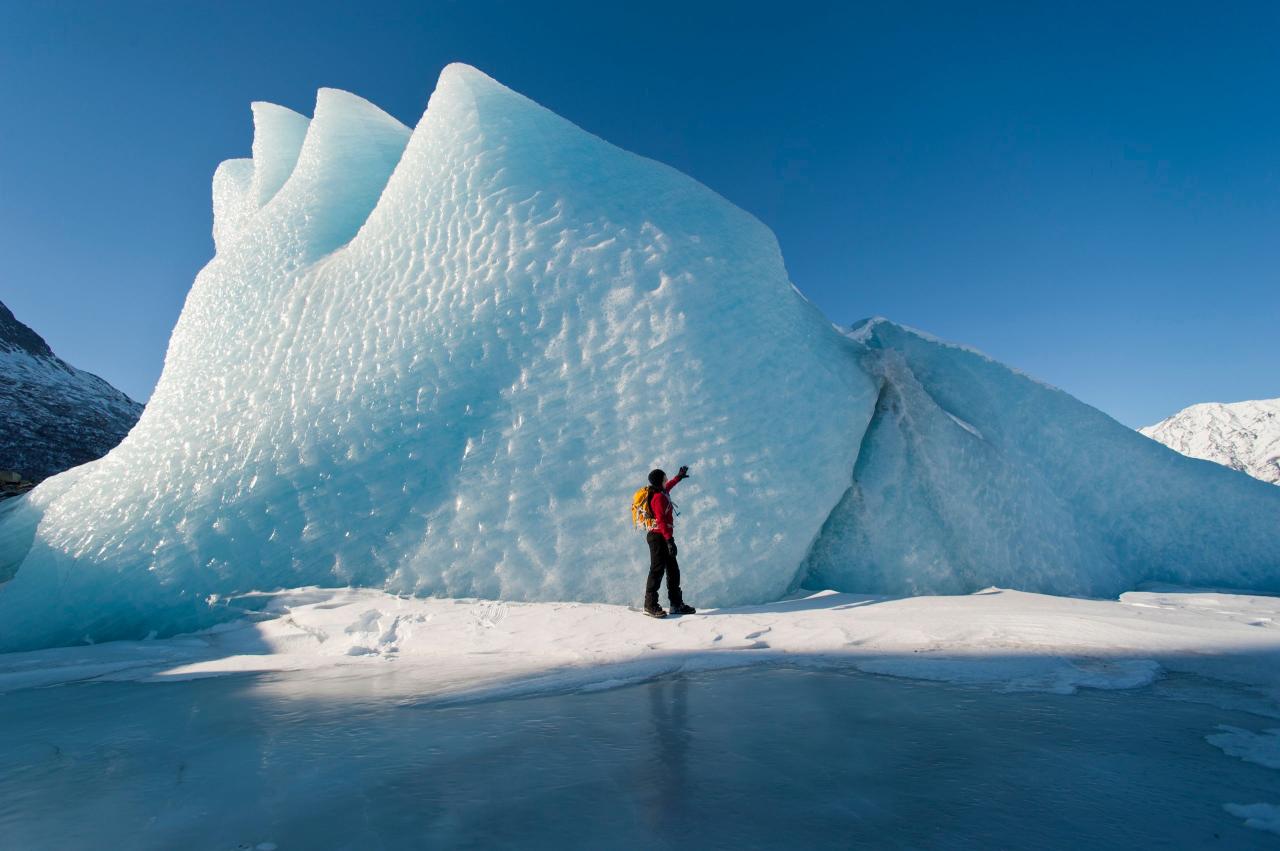
Alaska’s breathtaking landscapes and rich biodiversity attract millions of tourists each year, but the burgeoning cruise ship industry presents unique environmental challenges. The sheer volume of cruise ships visiting Alaskan waters raises concerns about pollution, waste disposal, and the potential impact on delicate ecosystems. Balancing the economic benefits of tourism with environmental protection is crucial for the long-term health of Alaska’s natural treasures.The influx of cruise ships brings a complex web of environmental impacts.
From the discharge of wastewater and the emission of greenhouse gases to the potential for accidental spills, the potential for damage is significant. Sustainable practices are critical to mitigating these risks and ensuring the continued beauty and biodiversity of Alaska’s wilderness for future generations.
Impact of Cruise Ship Traffic on Alaskan Ecosystems
Cruise ships, while offering a unique travel experience, can have a profound impact on Alaska’s pristine ecosystems. The sheer volume of vessels, combined with the concentration of passengers and crew, puts a strain on the delicate balance of marine life. Discharges of wastewater, including greywater and sewage, can introduce harmful pathogens and pollutants into sensitive waterways, potentially harming marine mammals, fish, and other organisms.
Noise pollution from ship engines can disrupt marine mammal communication patterns, impacting their foraging and breeding behaviors. The potential for oil spills, while relatively rare, can have catastrophic consequences for wildlife and coastal habitats. Furthermore, the increased presence of human activity in sensitive areas can alter natural behaviors and disrupt the natural balance of ecosystems.
Measures to Mitigate Environmental Damage
Various measures are being implemented to minimize the environmental impact of cruise ships. Regulations regarding wastewater discharge, ballast water management, and emission standards are becoming increasingly stringent. Cruise lines are also adopting practices to reduce their environmental footprint, such as investing in cleaner fuels and optimizing ship designs for fuel efficiency. Improved waste management systems, including better waste segregation and recycling programs on board, are contributing to reducing pollution.
The development and implementation of educational programs for passengers and crew on responsible environmental practices is crucial in promoting awareness and encouraging mindful behavior.
Alaska is set to welcome a record number of cruise visitors this year, a fantastic boost for the local economy. This surge in tourism, however, follows some interesting changes in the industry, like the departure of Veitch from NCL after 8 years. This change might subtly influence the overall cruise experience for travelers, but the high volume of visitors heading to Alaska suggests that this year’s cruise season is shaping up to be incredibly popular.
Comparison of Cruise Ship Practices, Alaska to get record cruise visitors this year
Different cruise lines demonstrate varying levels of commitment to environmental sustainability. Some lines have adopted stricter environmental policies, investing in cleaner technologies and implementing rigorous waste management programs. Others lag behind, continuing to utilize older, less environmentally friendly technologies. Transparency in environmental performance reporting and independent audits are essential for assessing and comparing the practices of different cruise companies.
Impact of Cruise Ship Waste and Emissions
Cruise ship waste, including sewage, garbage, and greywater, poses a significant threat to marine ecosystems. The sheer volume of waste generated by a large number of passengers and crew can overwhelm local waste management systems. Emissions from cruise ships contribute to air pollution, releasing greenhouse gases and other pollutants into the atmosphere. The resulting increase in greenhouse gases contributes to climate change, impacting Alaska’s delicate ecosystems and potentially causing sea level rise, affecting coastal communities.
This can be further complicated by the potential for accidental spills and releases of hazardous materials.
Table Contrasting Environmental Policies and Regulations for Cruise Ships
| Criteria | Policy/Regulation 1 (Example) | Policy/Regulation 2 (Example) |
|---|---|---|
| Wastewater Discharge Standards | Stricter limits on pollutants allowed in discharged wastewater | Mandatory treatment of wastewater before discharge |
| Ballast Water Management | Regulations on the use of ballast water to prevent the introduction of invasive species | Mandatory ballast water treatment systems on ships |
| Emission Standards | Requirement to use cleaner fuels or implement emission reduction technologies | Specific standards for NOx and SOx emissions |
| Waste Management | Mandatory waste segregation and recycling programs | Stricter regulations on the disposal of hazardous waste |
Challenges and Opportunities
Alaska’s burgeoning cruise tourism presents a complex tapestry of opportunities and challenges. While record visitor numbers promise economic benefits, careful planning and management are crucial to ensure that this growth doesn’t come at the expense of the environment or the well-being of local communities. Sustainable practices must be integrated into every aspect of cruise operations to minimize the potential negative impacts and maximize the positive contributions.The influx of cruise ships, while generating revenue, can strain existing infrastructure, impacting local businesses, and potentially harming sensitive ecosystems.
Finding a balance between economic gain and environmental protection is essential for Alaska’s long-term prosperity. Strategies must address these challenges proactively to ensure the continued enjoyment of Alaska’s natural wonders for future generations.
Challenges Associated with Increased Cruise Tourism
Alaska’s unique environment and infrastructure face strain under heightened cruise ship traffic. Increased congestion at ports and related facilities can disrupt local operations and increase wait times. The influx of large numbers of tourists can overwhelm local resources, potentially leading to increased waste generation, traffic issues, and strain on public services like sanitation and waste management. Furthermore, the sheer volume of cruise ships can disturb delicate marine ecosystems, leading to noise pollution, potential damage to coral reefs, and increased risk of invasive species introductions.
In addition, potential impacts on local communities include increased competition for housing and resources, strain on infrastructure, and the need for enhanced infrastructure to handle the larger volume of visitors.
Opportunities Presented by Increased Tourism
Record cruise visitor numbers present substantial opportunities for economic development in Alaska. Increased revenue can be used to fund crucial infrastructure improvements, including better transportation systems, upgraded public facilities, and expanded healthcare services. This increased revenue can also stimulate local businesses and create job opportunities in sectors like hospitality, tourism, and transportation. Crucially, increased tourism can raise awareness about the importance of environmental protection, potentially leading to community engagement in conservation efforts.
Strategies to Manage Visitor Influx and Preserve the Environment
Effective strategies are essential to manage the influx of cruise visitors while preserving the environment. Implementing strict waste management protocols, including responsible waste disposal and recycling programs, is critical to minimize environmental damage. Promoting responsible tourism practices, such as educating visitors about environmental sensitivities and encouraging responsible wildlife viewing, can significantly reduce the impact of tourism on the delicate ecosystems.
Furthermore, collaboration between cruise lines, local governments, and environmental organizations can ensure that environmental concerns are addressed effectively. This includes the development of comprehensive visitor management plans that address issues like waste disposal, infrastructure capacity, and visitor behaviour.
Potential Solutions for Balancing Tourism Growth with Environmental Protection
Balancing economic growth with environmental protection requires a multi-faceted approach. Cruise lines should adopt stringent environmental standards, such as employing cleaner fuel technologies and implementing waste management strategies. Local communities can create educational programs for visitors, emphasizing respect for the environment and promoting sustainable practices. Government agencies can establish clear regulations and enforce them to ensure environmental protection and responsible tourism practices.
This includes setting visitor limits, implementing stricter waste disposal regulations, and encouraging the use of eco-friendly transportation options.
Table of Potential Strategies to Mitigate Negative Impacts
| Challenge | Potential Strategy | Expected Outcome |
|---|---|---|
| Increased Waste Generation | Stricter waste management regulations for cruise lines, mandatory waste segregation on ships, and expanded recycling facilities in ports. | Reduced environmental impact, improved waste management infrastructure, and less pollution. |
| Infrastructure Strain | Prioritize investments in port infrastructure, expand waste management capacity, and improve transportation systems. | Improved infrastructure, better handling of waste, and more efficient transportation for visitors. |
| Ecosystem Disturbance | Implement noise mitigation measures, restrict cruise ship routes near sensitive ecosystems, and promote responsible wildlife viewing practices. | Reduced noise pollution, protection of marine life, and preservation of biodiversity. |
| Strain on Local Resources | Develop visitor management plans, implement visitor limits, and promote eco-friendly accommodation options. | Controlled visitor numbers, less strain on local resources, and reduced impact on local communities. |
Tourism Management Strategies
Alaska’s surge in cruise tourism presents both opportunities and challenges. Effective management strategies are crucial for maximizing the economic benefits while minimizing negative impacts on the environment and local communities. Careful planning and proactive measures can ensure that this influx of visitors enhances Alaska’s unique character and sustainability.
Effective Tourism Management Strategies in Similar Destinations
Many destinations experiencing significant tourism growth have implemented successful strategies. For example, the Hawaiian Islands have implemented visitor management plans that regulate the number of visitors to specific areas, thereby mitigating environmental damage and preserving the natural beauty. Similarly, destinations in the Mediterranean have utilized reservation systems and timed entry to control visitor flow and enhance visitor experience.
These strategies demonstrate that proactive planning and visitor flow management are key to responsible tourism development.
Alaska is on track for a record-breaking cruise season this year, with a surge in visitors. This boom is likely fueled by clever marketing strategies, like those employed by early online travel agents (OTAs). Understanding how these pioneers in online travel advertising, such as advertising and the pioneer OTAs , shaped the industry can help us appreciate the complex forces behind the current Alaska cruise popularity.
It’s safe to say that a combination of improved accessibility and targeted marketing is behind the exciting numbers.
Best Practices for Managing the Flow of Cruise Visitors
Implementing visitor-flow management is crucial. This involves creating detailed itineraries for cruise ship arrivals, optimizing dock scheduling to minimize congestion, and coordinating with local transportation providers to ensure smooth passenger movement. Developing clear signage and information dissemination plans for cruise visitors are essential components for facilitating a smooth and enjoyable experience for everyone. This approach ensures efficient use of infrastructure and avoids overcrowding in sensitive areas.
Designing a Model for Allocating Resources to Manage Increased Cruise Ship Traffic
A model for resource allocation requires a multifaceted approach. This includes dedicated staff for cruise visitor management, investment in infrastructure improvements such as enhanced port facilities, and a well-defined communication strategy to keep all stakeholders informed. A portion of the revenue generated from cruise tourism could be allocated to fund environmental conservation projects, enhance community infrastructure, and support local businesses.
Alaska is expecting a record number of cruise visitors this year, a testament to its breathtaking scenery. For a more intimate and personalized experience, consider a bite size sailing experience, perfect for those wanting to truly immerse themselves in the Alaskan wilderness, offering a unique perspective compared to large cruise ships. a bite size sailing experience might just be the perfect complement to the bustling cruise ship scene.
This will surely enhance the overall experience for all the record-breaking cruise tourists.
This allocation model would ensure sustainable development while maximizing the economic benefits of cruise tourism.
Ensuring Sustainable Tourism Practices are Implemented
Sustainable tourism practices are vital for long-term success. This requires implementing strict environmental regulations for cruise ships and promoting responsible behavior among tourists. Promoting eco-friendly activities and partnerships with local communities are essential elements. Crucially, this involves education and awareness campaigns for both cruise line staff and tourists, emphasizing responsible resource consumption and respect for the local environment.
Steps to Implement a Comprehensive Tourism Management Plan
| Step | Description |
|---|---|
| 1. Assessment | Thoroughly assess current tourism infrastructure, visitor patterns, environmental sensitivities, and community needs. |
| 2. Policy Development | Develop comprehensive policies and guidelines that address environmental protection, visitor management, and community engagement. |
| 3. Stakeholder Engagement | Actively engage with cruise lines, local communities, environmental organizations, and government agencies to ensure a shared understanding and commitment to the plan. |
| 4. Implementation | Execute the plan, including infrastructure improvements, staff training, and communication strategies. |
| 5. Monitoring and Evaluation | Regularly monitor the plan’s effectiveness and make adjustments as needed to optimize its impact. |
End of Discussion
In conclusion, Alaska’s record cruise visitor numbers this year promise both exciting opportunities and significant challenges. Careful planning and proactive management are essential to maximize the economic benefits while mitigating the environmental and community impacts. Sustainable tourism practices, coupled with infrastructure improvements, will be key to ensuring a positive experience for both visitors and residents.
FAQ Section
What are the typical cruise ship itineraries in Alaska?
Typical itineraries often include stops at various ports along the Alaskan coastline, offering opportunities to see glaciers, wildlife, and stunning scenery. The duration of cruises varies, allowing tourists to experience Alaska for a few days or a week.
How many cruise ship visits are projected for each month this year?
The projected number of cruise ship visits for each month is detailed in a table within the article, allowing for a deeper understanding of the expected arrival patterns.
What are some potential solutions to manage the environmental impact of cruise ships?
Implementing stricter emission standards, promoting sustainable waste management practices onboard, and encouraging eco-friendly cruise ship design are potential solutions to mitigate environmental harm.
What are the current limitations of Alaska’s infrastructure regarding cruise ships?
Current limitations include the capacity of ports and related facilities, which may not be able to accommodate the projected increase in cruise ship traffic. This could lead to congestion and delays.

